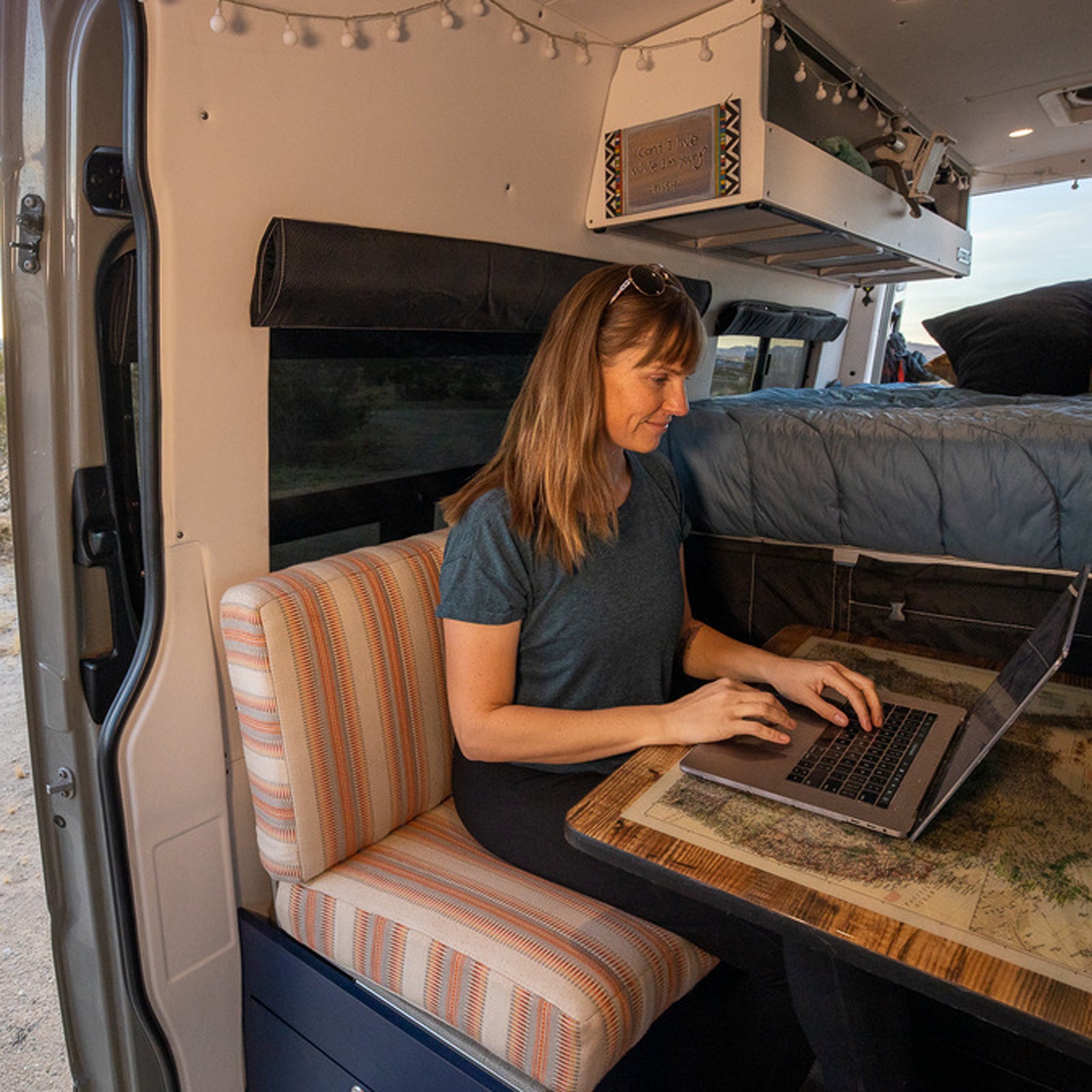At a time when most of us are working from home and companies are embracing remote routines, thereÔÇÖs been a renewed interest in the digital-nomad lifestyle. But what are the realities of #vanlife when you have a nine-to-five╠řjob or a business to run? Managing deadlines on the move, dealing with cramped quarters and distractions, and planning for connectivity issues can be major challenges, but only if youÔÇÖre unprepared. To find out how to do it successfully, I called , the adventure travel blogger and photographer behind . She started her blog in 2014 with the goal of making the outdoors more accessible, bought her first van in 2016, and has been living and working on the road ever since. HereÔÇÖs her advice on how to╠řstay productive.╠ř
Get the Right Rig
Bor bought her first van after having to pass╠řup an opportunity to hike the Grand Canyon because she had to get home to meet a deadline. ÔÇťI just thought, Man, if I had some sort of vehicle I could sleep and work in a little more comfortably than my Subaru, thatÔÇÖd be amazing,ÔÇŁ she says. After looking at everything from a travel trailer to a slide-in camper, Bor╠řsettled on a van for its╠řcomfortable interior, protection from the elements, and its open layoutÔÇöbecause she was a solo traveler, for safety reasons╠řshe wanted to be able to go from the bed to the driverÔÇÖs seat without leaving the car.
That first van, a 144-inch–wheelbase Mercedes Sprinter, was a learning process. Living it in full-time showed her what she actually wanted in an╠řadventuremobile. She eventually sold it and bought a╠ř170-inch-wheelbase Mercedes Sprinter, which has more interior space and comes equipped with a ╠ř(from $700), so she can continually charge all of her laptop and camera gear without running out of power.
If youÔÇÖll be staying in RV parks, or if you plan to be on the road for just a few days at a time and donÔÇÖt need for a lot of power, you can build your own solar╠řsystem or opt for a simpler portable option,╠ř (from $330).╠ř
Create a Dedicated Workspace
BorÔÇÖs number-one tip for actually getting work done on the road is to make sure that whatever rig you buy or build has a dedicated and comfortable working area. ÔÇťIn my first van, the bed doubled as the workspace, so that wasnÔÇÖt a really efficient way for me to work,ÔÇŁ she says.╠ř
In her new van, she has a cordoned-off space, with a 30-inch table on a ($133)╠řthat doubles as a kitchen counter. ThereÔÇÖs an outlet within armÔÇÖs reach and an adjacent storage space for easy access to her laptop and camera equipment.
Stay Connected╠ř
The tools youÔÇÖll need to be productive will largely depend on the nature of your work, but in general, youÔÇÖll want to look for a decent laptop with a large screen and good battery life. (Bor has a 15-inch MacBook Pro.)╠řDor says sheÔÇÖs seen vans with built-in desktop monitors, but everything is a trade-off when youÔÇÖre working with limited space. ÔÇťYou have to find that balance between how much space each item takes up with how much you use them,ÔÇŁ she╠řsays.
Since she runs her own business, Bor has an (from $30 a month). For simple tasks,╠řincluding╠řchecking email on the move,╠řshe simply connects her laptop to her phone. But during╠řmost of her working hours, she uses a , like VerizonÔÇÖs (from $99), which acts as a modem, allows╠řfor more than one person to access the internet, and usually lasts a full day on one charge.╠ř
Before settling on╠řa network provider, Bor recommends╠řthinking about what parts of the country youÔÇÖll be spending the most time in and checking for a map of coverage areas from different carriers. Once you pick a plan, youÔÇÖll have to be vigilant about staying within your providerÔÇÖs data zones and╠řchoosing╠řyour campsites accordingly.╠ř
In terms of managing your data so you donÔÇÖt have to deal with slowing connection speeds or overage charges, Bor advises╠řbeing mindful of what youÔÇÖre uploading and how much data youÔÇÖve used by relying on╠řan app like .
Embrace the Local Library
Sometimes work means having to upload large video files or relying on a faster connection than what youÔÇÖve got, which necessitates╠řheading into town and looking for a place with Wi-Fi. ÔÇťI prefer libraries, because even the tiniest of towns has one, and oftentimes╠řthe signal will be strong enough that you donÔÇÖt have to go in, you can just sit in the van parked outside,ÔÇŁ says Bor. Internet access at a local library is usually free, so itÔÇÖs a cheaper alternative to frequenting coffee shops and restaurants, where you have to make purchases to use their Wi-Fi.╠ř
Manage Your Time Effectively
Time management while traveling is tricky. Bor suggests╠řscheduling tasks that may require a faster internet connection, like video meetings or connecting to your companyÔÇÖs VPN, for the same day╠řso that you donÔÇÖt have to spend too many consecutive days stuck in a town.
For Bor, staying productive has also meant figuring out what time of day she does her best work╠řand scheduling her time on the road accordingly. To help with productivity and organization, she uses the apps for task management and for scheduling social-media posts. It can be difficult to set a schedule when there are so many activities and attractions╠řat your doorstep,╠řbut Bor uses the reward of exploring new places as motivation to get her work done. ÔÇťItÔÇÖs definitely taken some time to figure out. There are so many distractions when youÔÇÖre on the road,ÔÇŁ she╠řsays. ÔÇťYouÔÇÖre camped in these beautiful places, and there are trails all around you. You really have to be dedicated.ÔÇŁ


